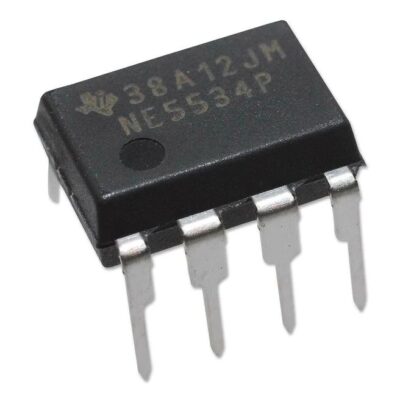NE5534P
Part Number: NE5534P
Manufacturer: Texas Instruments
Description: IC OPAMP GP 1 CIRCUIT 8DIP
Shipped from: Shenzhen/HK Warehouse
Stock Available: Check with us
ICRFQ.com - Electronic Components Distributor in China Since 2003

Part Number: NE5534P
Manufacturer: Texas Instruments
Description: IC OPAMP GP 1 CIRCUIT 8DIP
Shipped from: Shenzhen/HK Warehouse
Stock Available: Check with us
| Datasheet | |
|---|---|
| Category | Integrated Circuits (ICs) |
| Family | Linear – Amplifiers – Instrumentation, OP Amps, Buffer Amps |
| Manufacturer | Texas Instruments |
| Series | – |
| Packaging | Tube |
| Part Status | Active |
| Amplifier Type | General Purpose |
| Number of Circuits | 1 |
| Output Type | – |
| Slew Rate | 13 V/μs |
| Gain Bandwidth Product | 10MHz |
| -3db Bandwidth | – |
| Current – Input Bias | 500nA |
| Voltage – Input Offset | 500μV |
| Current – Supply | 4mA |
| Current – Output / Channel | 38mA |
| Voltage – Supply, Single/Dual (±) | 10 V ~ 30 V, ±5 V ~ 15 V |
| Operating Temperature | 0°C ~ 70°C |
| Mounting Type | Through Hole |
| Package / Case | 8-DIP (0.300″, 7.62mm) |
| Supplier Device Package | 8-PDIP |
Operational amplifiers (op-amps) such as the NE5534P have been around for a while and are known for their great performance. Produced by an American semiconductor company, Signetics, it debuted in 1978. (now part of NXP Semiconductors). The NE5534P has quickly become popular for audio systems, especially high-end stereo components.
This manual will provide an in-depth introduction to the NE5534P, including its characteristics, specifications, and potential uses.
All four devices—the NE5534, SA5534, NE5534A, and SA5534A—are high-performance operational amplifiers with exceptional dc and ac characteristics. The unity-gain and maximum-output-swing bandwidths, the level of distortion, and the slew rate are all exceptionally high, and the noise floor is extremely low. These operational amplifiers have an in-built gain compensation circuit for gains greater than 3. For optimum performance across a wide range of applications, installing an external compensating capacitor between COMP and COMP/BAL is recommended. The BALANCE and COMP/BAL pins can be used to disable the devices’ offset voltage, and the inputs and outputs are both protected from short circuits. Limits on equivalent input noise voltage are set for the NE5534A and SA5534A devices.
Because of its versatile set of features, the NE5534P can be used in various contexts. Among its many impressive features and capabilities are the following:
The NE5534P has found widespread use in audio applications, especially in hi-fi and other expensive audio systems. It’s most often used for, among other things:
In operational amplifiers (op amps), the differential input stage is vulnerable to various causes of input offset voltage, such as collector currents, mismatched transistor pairs, current gain betas (), collector or collector or emitter resistors, and so on. These input offset pins allow the designer to add external circuitry to correct these discrepancies.
Slew rate refers to how quickly the output of an operational amplifier can change in response to a modification in the input. The slew rate of both the NE5534 and the SA5534 is 13 V/s.
If an amplifier has a high common-mode rejection ratio (CMRR), it can effectively filter out interference that would otherwise be present on both input terminals. It is calculated by dividing the percentage of change in input offset voltage by the percentage of change in input voltage and then expressing the result in decibels. Amplifiers are optimized to have a CMRR as high as feasible, while ideally, it would be infinite. Both the NE5534 and the SA5534 have a CMRR of 100 dB.
How high of a frequency range may a unity-gain amplifier be used before significant signal distortion occurs? A 10 MHz unity-gain bandwidth is standard for the NE5534 and SA5534 chips.
Upon supply connection, both the NE5534 and SA5534 are activated. Depending on the situation, Each of these parts can use either a single-supply operational amplifier or a dual-supply amplifier. General Application
There are many sources of input offset voltage in operational amplifiers (op amps), including incompatible transistor pairs, collector currents, current gain betas (), collector or emitter resistors, and so on at the differential input stage of the op-amp circuit. The designer can use external circuitry to compensate for these mismatches by connecting to the input offset pins. Using resistors or a potentiometer between the inputs enables the user to fine-tune the level of these input mismatches. When testing the circuit or using it in a setting requiring precise offset control, a potentiometer can be used to fine-tune the circuit. Addition details on how to use the input-offset pins in your designs.
Whenever a low-power signal must be utilized to power a high-current load, the operational amplifier’s voltage follower arrangement comes into play. A unity gain amplifier or buffer amplifier is another name for this circuit. A very high resistance at the inputs of the operational amplifier results in the very little current drain from the power supply. As the operational amplifier’s output resistance is so low, it can supply as much current as is required to the load.
In conclusion, the NE5534P is a reliable and versatile op-amp that offers exceptional performance for audio applications. Its low noise, high gain, low distortion, and wide bandwidth make it a popular choice among audio enthusiasts and professionals alike. If you’re looking to enhance the performance of your audio project, the NE5534P is definitely worth considering.
You can easily obtain this high-quality component by ordering with ICRFQ, a reputable supplier of premium electrical components. With their excellent products and outstanding customer service, you can rest assured that you’ll receive the best possible experience. Don’t miss out on the opportunity to elevate your project’s performance – order the NE5534P now from ICRFQ!
WhatsApp us